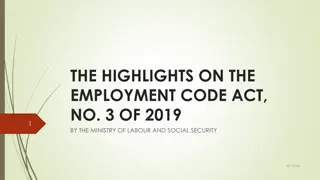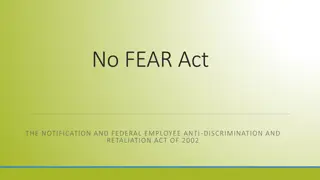Understanding USERRA: Uniformed Service Employment Rights Act 1994 Overview
The Uniformed Service Employment and Reemployment Rights Act (USERRA) of 1994 provides job protection for individuals leaving employment for military service. It prohibits discrimination against uniformed services members and applicants. This Act covers various duty types and specifies rules for benefits continuation during military service. Learn about USERRA, its key provisions, and how it impacts employment rights.
Download Presentation

Please find below an Image/Link to download the presentation.
The content on the website is provided AS IS for your information and personal use only. It may not be sold, licensed, or shared on other websites without obtaining consent from the author. Download presentation by click this link. If you encounter any issues during the download, it is possible that the publisher has removed the file from their server.
E N D
Presentation Transcript
Uniformed Service Employment and Uniformed Service Employment and Reemployment Rights Act of 1994 Reemployment Rights Act of 1994 (USERRA) (USERRA) CPT Beth D Atri Ms. Jessica D Amato 808-672-1234 Beth.a.datri.mil@mail.mil 808-672-1229 Jessica.m.damato.civ@mail.mil
Administrative Notes Administrative Notes Keep your microphone on mute unless called upon Raise your hand if you have a question/ comment or use the chat bar If you cannot see the slides, you can download from the HRO Website or let us know so we can email to you
Agenda Agenda What is USERRA? USERRA: Absent Uniformed Services Packet Overview USERRA: Return-to-Duty Packet Overview
What is USERRA? What is USERRA? Effective 12 December 1994 USERRA protects the job rights of individuals who voluntarily leave employment positions to undertake military service. USERRA also prohibits employers from discriminating against past and present members of the uniformed services, and applicants to the uniformed service. Limited to 5 cumulative years for Title 32 and Title 10. Exempted duty types below: Exempted duty types include: T10, USC, Sections 688, 10147, 12301(a), 12301(d), 12301(h) 12301(g), 12302, 12304, 12304(a), 12304(b), 12305 and 12406 T32, USC, Sections 502(a), 502(f)(2)(A) when ordered to full-time NG duty (other than training) by the President or the Secretary of Defense for the purpose of responding to a national emergency declared by the President and supported by federal funds, and 503
Absent Absent- -Uniformed Service Uniformed Service Benefits CAN be continued through military service but they are treated differently based on the type of orders the employee will be on. It is up to the employee to make elections that best suit their needs. Next, we are going to go step-by-step through the checklist! Note: The checklist is 4 pages, it is very important that you pay attention to each section and initial or put N/A if necessary.
Setting the Setting the Effective Date Effective Date The Absent-US personnel action will be processed with an effective date the same as their military orders UNLESS the employee decides to use authorized available leave. EXAMPLE: Employee orders start January 1, normally the Absent-US would be effective January 1 but the employee has 40 hrs of regular comp time they want to use so the effective date for the Absent-US (KG) is January 6 (1-5 on Comp). 4/16/2020
Leave Leave Once HRO processes the AUS, employees will be hard coded as Absent-US (KG), timekeepers can still code the following types of leave while the employee is on orders: Military Leave (LM) under 5 U.S.C. 6323 Annual Leave (LA) under 5 U.S.C. 6304 Sick Leave (LS) (In accordance with regulation) 5 U.S.C. 6307 If paid leave is used while in Absent-US: FEHB is retained, premiums deductions will still occur FEGLI deductions will still occur TSP and all other deductions will still occur FERS (if applicable) deductions will also be deducted All paid leave will not be considered/ included for calculations for MSD
FEHB FEHB Employees must elect to terminate or continue FEHB coverage during the military service period. If FEHB is retained in a CONTINGENCY OPERATION: Premiums paid by agency for up to 24 months To receive FEHB coverage at no cost, must be: 1.) ENROLLED 2.) Reserve Component Member in a non-pay status 3.) Called to duty in support of contingency operation (10 USC Section 101(a) (13) ) 4.) On active duty for more then 30 consecutive days If FEHB is terminated: Dates are determined by the employee based on individual circumstances Termination is not a break in continuity of coverage for the purpose of eligibility to continue coverage as an annuitant Employee has 31 day extension of coverage Can Reinstate FEHB upon Return to Duty FEHB Elections continue
FEHB FEHB If FEHB should continue based on a non-contingency operation, the employee has two options: 1.) Elect to pay the premium directly. Must be a minimum payment of the employee s share of the premium for two pay periods. Please make your check or money order payable to DFAS-Cleveland. Include on the check your name, social security number, note that the payment is for FEHB premium and the pay period(s) for which the payment is being made. 2.) Elect to incur a debt, the repayment of the debt is deducted from your pay when you return to a pay status. ***first 12 months employee is responsible for their share of the premiums ***second 12 months, employee is responsible for their share, plus the governments hare plus 2% for admin costs/fee ***after 24 months, FEHB is terminated.
Premium Premium Conversion Conversion Premium conversion is a pre-tax arrangement in which the part of an employee s salary that goes for Federal Employees Health Benefits (FEHB) program premiums becomes non-taxable. This means that participants save on federal income tax and Social Security and Medicare taxes. In most cases, they also save on state income tax and local income tax. Conversion is automatic at enrollment unless waived and once you participate, your participation continues automatically unless you waive it. Highly recommend all employees submit the Form HB-PC with your Absent-US checklist. It can be found here, (https://dod.hawaii.gov/hro/files/2012/12/Encl-3_Form- HB-PC.doc)
Transitional Tricare Transitional Tricare Contingency Operations may provide 180 days of Tricare once orders end
Federal Employees Group Federal Employees Group Life Insurance (FEGLI) Life Insurance (FEGLI) Continues at no cost to the employee for up to 12 months in Absent-US status when in a non-pay status (if paid leave is taken, a debt occurs) Options: Terminate at end of 12 months free coverage Retain or Reduce Optional Coverage after end 12 months **If retained, employees pays premium payments for both agency AND employee share
Flexible Spending Flexible Spending Account (FSA) Account (FSA) It is the employees responsibility to contact FSAFEDS directly for any changes to FSA
ARNG only Contact FEDVIP directly Contact FLTC directly Military Deposit: If you are a Federal Employee Retirement System (FERS) or Civilian Service Retirement System (CSRS) employee, the period of Absent-US for military duty is creditable toward potential civilian retirement only if you make a service-credit deposit to cover this period of service. (We will cover this during the RTD portion of this brief)
Thrift Savings Thrift Savings Program (TSP) Program (TSP) If you choose not to submit an application to make Retroactive TSP Contributions you will not be eligible for any matching TSP contributions that you would have received if you had not been placed in an Absent- US status.
Questions Questions 5 min break Take a brief stretch and drop any questions in the chat bar.
Return Return- -to Duty (RTD) to Duty (RTD) When returning to duty you have three options on when to come back to your civilian position: 1. Return the day after your orders end. 2. Return while on terminal leave, but not PDMRA leave. (attach approved DA form 31 to SF 52) 3. Return within 14 days after orders end, for orders that are longer than 90 days but less than 180 days 4. Return up to 90 days after your orders end, for orders longer than 180 days Packets should be submitted NLT 14 days prior to your return to work, but earlier is better, it will give us time to process prior to your first pay period. If you extend your orders after you submitted your RTD Packet, make sure to contact us.
RTD RTD Submit this form with all of your orders, mods/amendments, DD214 for the service period If you do not RTD within the listed time frame, you will be separated from your position without any reemployment rights.
Determining your Determining your RTD Date RTD Date You must annotate what will be your first day back at work
Reservist Reservist Differential Differential You will only receive this if you make less as a member of the military than you make as a civilian. Federal employees who are in a leave without pay status due to a contingency operation will receive the difference in pay from their military pay to their civilian pay. Your Military Pay includes Basic Pay, BAS, BAH, FSA-II, Hardship Location, Hostile Fire pay You do not receive reservist differential if you use any type of leave during a pay period. If an employee is entitled to reservist differential payment, upon returning to duty, the EMPLOYEE should provide any remaining military LESs and a copy of his/her DD 214 as soon as possible to the Employee Service Office.
FEHB FEHB Once you have Returned to Duty (RTD) you may enroll, cancel, or continue your (FEHB) - If you choose to keep the FEHB election you had before you were placed in Absent-US you do not need to do anything but you can make changes to your existing FEHB If you choose to enroll in FEHB you have three Qualifying Life Events (QLE s) on which you may enroll. 1. Returning to Duty- QLE 1F- only if you cancelled FEHB when you were placed in Absent-US (AUS) . You may enroll up to 60 Days after you RTD. Supporting documentation is your SF 50 for RTD. 2. When your Tricare converts to TAMPUS- QLE 1M- you may enroll up to 30 days before or 60 days after you are eligible for TAMPUS. Supporting documentation is a Tricare Certificate of Eligibility or DoD Dependent ID Card with a status of T-180. 3. When your TAMPUS ends- QLE 1M- you may enroll up to 30 days before or 60 days after you are eligible for TAMPUS. Supporting documentation is your DoD Dependent ID Card with a status of T-180.
FEHB FEHB You may choose to cancel your FEHB coverage because you are eligible for TAMPUS (QLE 1M). If you choose to cancel It must be completed through ABC-C. The cancellation becomes effective the last day in the pay period in which we receive it without a 31 day grace period. - If you transfer to another Federal agency, your cancellation follows you to that agency. - If you separate from your employment, you will not be eligible for temporary continuation of coverage (TCC). - If you retire, you will not have an FEHB enrollment to continue into retirement. - If have a break in health benefit coverage by a federal health benefit program within 5 years from the date of retirement you may not be eligible for FEHB after your retirement . - You may not reenroll in FEHB until you loose your TAMP coverage or have another qualifying life event (QLE) that permits enrollment, or until the next FEHB Open Season.
RTD Packet contd RTD Packet cont d Initial each section for FSA, FLTCIP, FEDVIP, FEGLI, NGAUS or N/A if not applicable If you would like to change your coverage on those benefits, the contact information has been provided to you.
TSP TSP If you choose not to submit an application to make Retroactive TSP Contributions you will not be eligible for any matching TSP contributions that you would have received if you had not been placed in an Absent-US status. DEADLINE- TSP ACTIONS MUST BE INITIATED WITHIN 60 DAYS OF YOUR RETURN TO A TECHNICIAN STATUS. Three Types of TSP Contributions: 1.) Agency Automatic 1% 2.) TSP Employee Contributions 3.) TSP Agency Matching Contributions
Agency Automatic 1% (FERS Only) Agency Automatic 1% (FERS Only) This is a contribution this agency puts in your TSP account based on your salary whether you contribute or not. You are entitled to YOUR automatic 1% agency contribution upon your return to duty. This is calculated by TSP and may take several months to show up in your TSP account. This is automatic and you do not need to fill out anything to receive the Agency Automatic 1%.
Make Make- -up Employee Contributions up Employee Contributions If you were placed in Absent-US (LWOP-US) you can make up contributions from the periods your were in Absent-US (LWOP-US) . - Contributions will be based on the TSP-1 on file or one submitted with your paperwork. Please fill out and attach USERRA RETROACTIVE TSP CONTRIBUTIONS form, if applicable. - Make-up contributions will be deducted from your civilian LES. You can choose to spread your deductions out for up to 2 times the amount of pay periods you were gone. This means your TSP contributions will be combined on your LES. *Can be found on our HRO Website: https://dod.hawaii.gov/hro/files/2020/06/Retro-TSP-upon-RTD-Revised-June-2012.pdf
Military Service Military Service Deposit Deposit If you are a Federal Employee Retirement System (FERS) or Civilian Service Retirement System (CSRS) employee, the period of Absent- US for military duty is creditable toward potential civilian retirement only if you make a service-credit deposit to cover this period of service. Step-by-Step directions for military service deposit are available on our website at: https://dod.hawaii.gov/hro/military-service- deposit-2/
References References NGB USERAA Guide Dated 12 February 2016 Chapter 43 Title 38 U.S.C. 5 CFR 353, 20 CFR Part 1002 Uniformed Employment and Reemployment Act of 1994
Additional Additional Resources Resources
Contact Us Contact Us Email the group mailbox: ng.hi.hiarng.mbx.nghi-hro-benefits@mil.mil
Questions? Questions?























